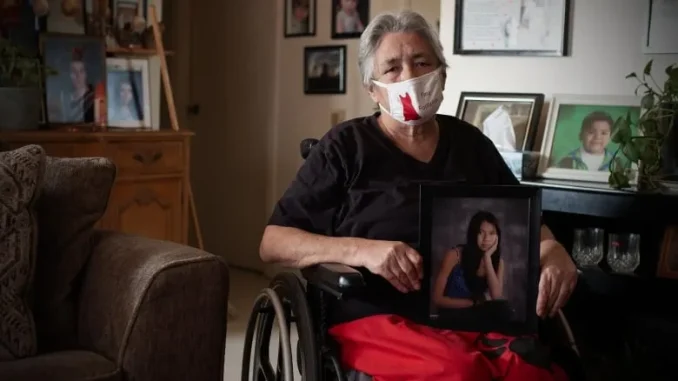
Tina Fontaine’s story is one of heartache and tragedy, but it is also a story of resilience, community, and the ongoing fight for justice for Indigenous women and girls. Ten years after her body was discovered in the Red River in Winnipeg, Tina’s legacy continues to impact her community, her family, and the nation. This blog post delves into the profound loss experienced by her family, particularly her great-aunt Thelma Favel, who was Tina’s primary caregiver, and the broader implications of her death on the fight against violence towards Indigenous women in Canada.
The Heartbreaking Loss:
Tina Fontaine’s life was tragically cut short at the tender age of 15. In August 2014, her lifeless body, wrapped in a duvet cover and weighed down with rocks, was pulled from the Red River in Winnipeg. Her death not only devastated her family but also shocked the nation, bringing to light the severe vulnerabilities faced by Indigenous youth in Canada. This section will explore the circumstances leading to her disappearance, her struggles within the child welfare system, and the lasting impact of her death on her community and the nation.
Tina’s life was filled with challenges from an early age. Raised by her great-aunt Thelma Favel, Tina had a close bond with her family but faced the typical struggles of a teenager, compounded by her Indigenous background and the systemic issues plaguing her community. After leaving her home to reconnect with her mother in Winnipeg, Tina found herself in a vulnerable position, moving between homes, shelters, and eventually coming into contact with the child welfare system. Despite these interactions, the system failed to protect her, leading to her tragic death.
The discovery of Tina’s body ignited a wave of national outrage, drawing attention to the ongoing crisis of Missing and Murdered Indigenous Women and Girls (MMIWG) in Canada. Her death became a symbol of the systemic failures that continue to put Indigenous women and girls at risk. This section will detail the events leading up to her disappearance, the investigation into her death, and the subsequent trial that left her family without the justice they so desperately sought.
Thelma Favel:
Thelma Favel has been a pillar of strength for her family, despite the immense pain she has endured since Tina’s death. As Tina’s primary caregiver, Favel shared a deep bond with her grand-niece, and the loss of Tina has left an indelible mark on her life. This section will explore Favel’s journey over the past decade, her grief, and the ways she has coped with the loss of her beloved Tina.
Favel’s living room, adorned with photos of her family, serves as a constant reminder of the vibrant life Tina once led. The curtains, which have remained closed since Tina’s death, symbolize the deep sorrow that Favel has carried for the past ten years. Despite the pain, Favel has remained steadfast in her commitment to keeping Tina’s memory alive and fighting for justice for all MMIWG.
Over the years, Favel has faced numerous challenges, including the painful experience of seeing the man accused of Tina’s murder, Raymond Cormier, acquitted in 2018. The lack of closure has been a heavy burden for Favel, but she has continued to advocate for change, drawing strength from her love for Tina and her desire to see no other family endure the same pain. This section will also touch on Favel’s health struggles, including her ongoing cancer treatment, and her decision to finally say goodbye to Tina in a heartfelt letter at her gravestone.
The Unanswered Questions:
The trial of Raymond Cormier, the man accused of killing Tina Fontaine, was a pivotal moment in the search for justice for Tina. Despite the overwhelming public outcry and the evidence presented during the trial, Cormier was acquitted of second-degree murder charges in 2018, leaving Tina’s family and supporters devastated. This section will examine the details of the trial, the evidence presented, and the reasons behind the jury’s decision to acquit Cormier.
The case against Cormier was built on circumstantial evidence, including recorded conversations in which he made incriminating statements. However, the prosecution struggled to definitively prove that Cormier was responsible for Tina’s death. The defense argued that the evidence was insufficient to convict Cormier beyond a reasonable doubt, leading to his eventual acquittal.
The outcome of the trial highlighted significant flaws in the justice system, particularly in cases involving Indigenous victims. The acquittal was seen by many as a miscarriage of justice, fueling further outrage and calls for systemic change. This section will explore the impact of the trial on Tina’s family, the Indigenous community, and the broader movement for justice for MMIWG.
The Broader Impact:
Tina Fontaine’s tragic death has come to symbolize the broader crisis of Missing and Murdered Indigenous Women and Girls (MMIWG) in Canada. Her case brought national and international attention to the issue, highlighting the systemic racism, discrimination, and violence that Indigenous women and girls face. This section will discuss how Tina’s story has influenced the MMIWG movement and the efforts being made to address this crisis.
The MMIWG crisis is deeply rooted in the history of colonialism, racism, and the ongoing marginalization of Indigenous peoples in Canada. Tina’s death underscored the vulnerabilities faced by Indigenous women and girls, particularly those who are involved in the child welfare system, experience poverty, or are otherwise marginalized. Her story resonated with many, prompting calls for justice and accountability from the government, law enforcement, and the broader society.
Tina’s death was a catalyst for the National Inquiry into Missing and Murdered Indigenous Women and Girls, which was launched in 2016. The inquiry’s final report, published in 2019, included 231 calls for justice, addressing various aspects of the crisis, from education and health to justice and policing. This section will examine the impact of the inquiry and the progress made since its conclusion, as well as the ongoing challenges that remain.
Sagkeeng Anicinabe Nation:
Sagkeeng Anicinabe Nation, the community where Tina was raised, has faced significant challenges in the years since her death. The loss of Tina and other members of the community to violence and tragedy has taken a heavy toll, but the community remains resilient and hopeful for a better future. This section will explore the struggles and hopes of Sagkeeng Anicinabe Nation as it works to heal and protect its members.
The community has experienced a high rate of missing and murdered Indigenous women and girls, with Tina’s death being one of the most high-profile cases. In the years since her passing, other tragedies have occurred, including the deaths of Tina’s cousin Jeanenne Fontaine and the disappearance of Samantha Hiebert and Leah Keeper. These losses have compounded the grief felt by the community and have underscored the urgent need for change.
In response to these challenges, Sagkeeng Anicinabe Nation has taken steps to protect its members and promote healing. The community is in the process of developing a family law that will give it greater jurisdiction and responsibility for the care of its children and families. Additionally, efforts are being made to establish a healing center for those struggling with addictions and a women’s shelter, though funding challenges have delayed these projects. This section will also highlight the community’s efforts to raise awareness and advocate for justice, including the annual feast and walk held in Tina’s honor.
Provincial and National Responses:
Tina Fontaine’s death sparked significant action at both the provincial and national levels, leading to various initiatives aimed at addressing the MMIWG crisis. However, progress has been slow, and many of the promises made in the wake of Tina’s death have yet to be fulfilled. This section will examine the responses from the government and other institutions, highlighting both the achievements and the shortcomings in the fight for justice.
At the provincial level, Manitoba has made some strides in addressing the MMIWG crisis, including the establishment of an MMIWG gender-based violence committee of cabinet and the creation of a Matriarch Circle to guide the province’s strategy on MMIWG. Additionally, the province has committed to a $15-million endowment fund to support MMIWG2S+ families. However, there is still much work to be done, particularly in areas such as youth mental health and the protection of at-risk youth.
Nationally, the federal government launched the National Inquiry into Missing and Murdered Indigenous Women and Girls, which culminated in a comprehensive report with 231 calls for justice. Despite the importance of this inquiry, the implementation of its recommendations has been slow, with many still unaddressed. This section will also discuss the role of grassroots organizations, Indigenous leaders, and activists in holding the government accountable and pushing for meaningful change.
A Call for Justice:
The fight for justice for Tina Fontaine and all Missing and Murdered Indigenous Women and Girls continues, driven by the tireless efforts of families, communities, and advocates. This section will focus on the ongoing challenges in addressing the MMIWG crisis and the urgent need for systemic change to protect Indigenous women and girls.
One of the most pressing issues is the need for better support and protection for Indigenous youth, particularly those who are at risk of exploitation, violence, and involvement in the child welfare system. Tina’s case highlighted the gaps in the system that failed to protect her, and these gaps continue to put other Indigenous youth at risk. This section will discuss the importance of implementing the recommendations from the National Inquiry and other reports, as well as the need for culturally appropriate services and support for Indigenous families.
The MMIWG crisis is not just a problem for Indigenous communities—it is a national crisis that requires the commitment and action of all Canadians. This section will also explore the role of non-Indigenous allies in supporting the fight for justice, including raising awareness, advocating for policy changes, and standing in solidarity with Indigenous communities.
The Future:
Despite the challenges, there is hope for the future. The efforts being made by Sagkeeng Anicinabe Nation, along with the broader MMIWG movement, are paving the way for a safer and healthier community for future generations. This section will explore the initiatives and programs being developed to protect and support Indigenous women and girls, as well as the importance of cultural revitalization and community healing in this process.
The development of Sagkeeng’s family law is a crucial step towards reclaiming jurisdiction over child welfare and ensuring that children remain connected to their culture and community. Additionally, the planned healing center and women’s shelter will provide much-needed support for those struggling with addictions and violence, helping to break the cycle of trauma that has affected so many families.
Cultural revitalization is also key to building a stronger community. By reconnecting with traditional practices, languages, and values, Indigenous communities can foster a sense of pride, identity, and resilience among their members. This section will highlight the importance of cultural initiatives, such as language programs, traditional ceremonies, and community gatherings, in promoting healing and empowerment.
Conclusion:
As we approach the tenth anniversary of Tina Fontaine’s death, it is essential to remember her not just as a victim, but as a symbol of the ongoing fight for justice and the resilience of Indigenous communities. Tina’s story continues to inspire action and change, reminding us of the urgent need to address the MMIWG crisis and protect the most vulnerable members of our society.

Leave a Reply